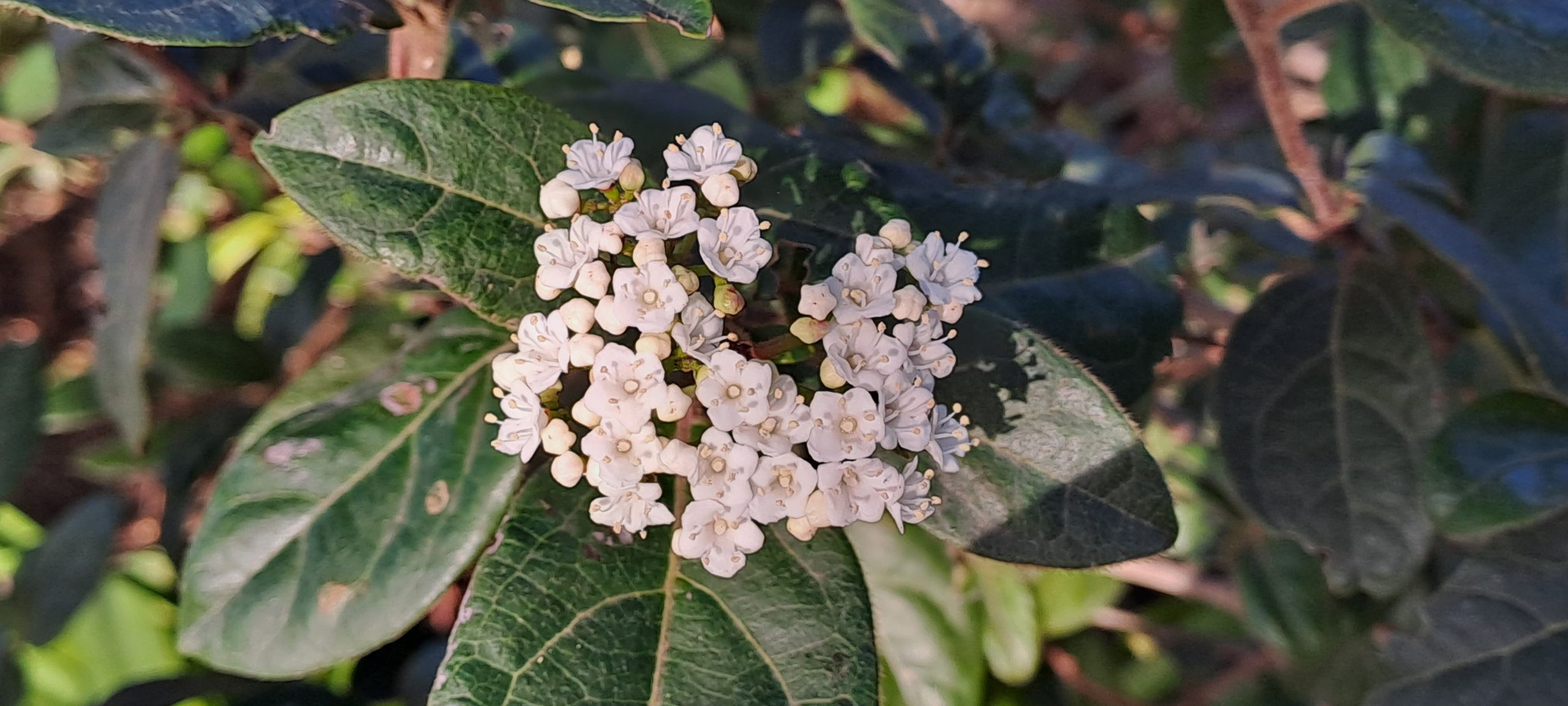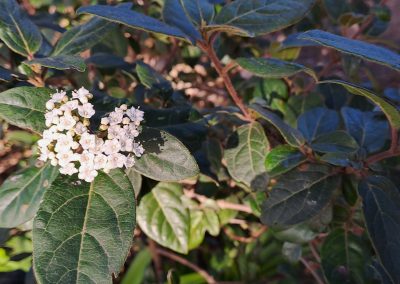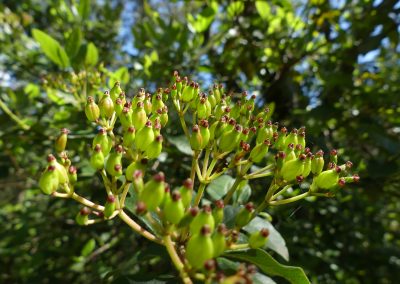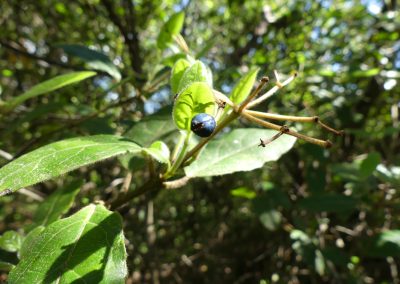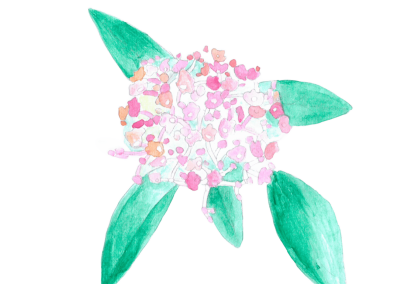Viburnum tinus
Scientific description
Taxon: Viburnum tinus
Class: Magnoliopsida
Subclass: Asteridae
Order: Dipsacales
Family: Adoxaceae (formerly Caprifoliaceae)
Common name: Laurustinus, Laurustinus Viburnum
Origin:
Native to the Mediterranean region of Europe and North Africa.
Description:
Evergreen shrub or small tree, 2–4 m tall, with dark green, glossy, leathery leaves. Clusters of small fragrant white to pale pink flowers appear late autumn to early spring, followed by metallic blue-black berries.
Propagation:
By seeds (slow germination), cuttings (semi-hardwood or hardwood in summer/early autumn), or layering.
Ecology:
Attracts bees and butterflies, provides berries for birds, tolerant of soil types, sun to partial shade, drought-tolerant once established, often used in hedgerows and shrub borders.
Uses:
Ornamental, wildlife gardens, hedging and screening.
Threats:
Aphids, viburnum beetle, scale insects, fungal diseases (powdery mildew, leaf spot), extreme cold, may naturalize in some regions.
Taxon: Viburnum tinus L.
Classe: Magnoliopsida
Sous-classe: Asteridae
Ordre: Dipsacales
Famille: Adoxaceae (anciennement Caprifoliaceae)
Nom commun: Laurier tin, Laurier sauvage, Laurustinus
Origine:
Région méditerranéenne (sud de l'Europe, nord de l'Afrique).
Description:
Arbuste persistant ou petit arbre, 2–4 m de haut, feuilles coriaces vert foncé, brillantes. Floraison blanche à rose pâle de décembre à avril, suivie de drupes bleu-noir métalliques.
Propagation:
Semis (lent), bouturage semi-ligneux en été, marcottage.
Écologie:
Préfère sols bien drainés, tolère sécheresse, supporte l'ombre partielle, attire abeilles et autres pollinisateurs, utilisé en haies et massifs.
Utilisation:
Ornemental, mellifère, haies et aménagement paysager.
Menaces:
Pucerons, cochenilles, oïdium, gel sévère, peut se naturaliser dans certaines régions.
Taxon: Viburnum tinus
Clasă: Magnoliopsida
Subclasă: Asteridae
Ordin: Dipsacales
Familie: Adoxaceae (anterior Caprifoliaceae)
Denumirea populară: Laur nobil, Viburnum de iarnă, Laur-tin
Origine:
Regiunea mediteraneană (sudul Europei, nordul Africii).
Descriere:
Arbust veșnic verde sau mic copac, 2–4 m, frunze eliptice, lucioase, verde închis. Flori albe sau rozalii parfumate iarna și primăvara, urmate de bace albastru-metalic.
Înmulțire:
Butași semilemnificați, semințe (dificil), marcotaj.
Ecologie:
Atrage polenizatori, oferă hrană pentru păsări, toleranță la soluri diverse, umbră parțială, rezistență la secetă odată stabilit, utilizat în garduri vii și borduri de arbuști.
Utilizări:
Ornemental, atrage polenizatori, gard viu sau masiv floral.
Amenințări:
Afide, păduchele lânos, trips, boli fungice (oïdium, pete foliare), sensibil la geruri extreme, se poate naturaliza local.
Ταξινόμηση: Viburnum tinus L.
Κλάση: Magnoliopsida
Υποκλάση: Asteridae
Τάξη: Dipsacales
Οικογένεια: Adoxaceae (πρώην Caprifoliaceae)
Κοινές ονομασίες: Λαουρίνος, Άγριος Δάφνος, Laurustinus
Προέλευση:
Μεσογειακή περιοχή (νότια Ευρώπη, βόρεια Αφρική).
Περιγραφή:
Αειθαλής θάμνος ή μικρό δέντρο, 2–4 μ., σκουροπράσινα, δερματώδη φύλλα με γυαλιστερή επιφάνεια. Μικρά, αρωματικά λευκά έως ωχρά ροζ άνθη αργά το φθινόπωρο μέχρι αρχή άνοιξης. Ακολουθούν μπλε-μαύροι καρποί.
Πολλαπλασιασμός:
Σπόροι (αργή βλάστηση), μοσχεύματα ημιξυλώδη/ξυλώδη, καταβολάδες.
Οικολογία:
Προσελκύει μέλισσες και πεταλούδες, τροφή για πουλιά, ανθεκτικό σε ποικιλία εδαφών, ήλιος έως ημισκιά, σχετικά ανθεκτικό στην ξηρασία, χρήση σε φράχτες και μπορντούρες.
Χρήσεις:
Καλλωπιστικό, κήποι άγριας ζωής, φυτοφράχτες.
Απειλές:
Αφίδες, σκαθάρι βιβούρνου, κοκκοειδή, μυκητιακές ασθένειες, έντονος παγετός, δυνατότητα αυτοφυούς εξάπλωσης σε ορισμένες περιοχές.
Creative writing inspired by Viburnum tinus
The unexpected encounter
One fine morning, as I was strolling through the fairy forest near my home, I caught sight of a shade of white and pink in the distance. As I approached, a Laurier Tin by the name of Youssef dazzled me with his imposing 3m height, causing me to tremble so much that I thought I'd turned into an ant. As I chatted with him, I realized that he wasn't so terrifying. On the contrary, it was a dense, easy-to-live-with shrub, and its beauty and vigor made me blush in spite of myself.
As it was still chilly, being winter, I invited him to my place for a cup of hot chocolate. As I walked alongside him, I saw how his dark-green, mysterious evergreen foliage moved in the wind, and the softness of his flowering buds contrasted with his foliage: he was a living work of art, rather like an impressionist painting. After arriving home, he asked me “What's that funny smell?” I replied that it was probably the scent of my roses. Youssef seemed surprised that a plant could give off a specific scent, as he didn't have one, so he approached the flowers to smell them.
Finally, after spending the afternoon together, he went home and I returned to my sofa, having discovered many things about Youssef, such as the fact that he was exposed to the sun and that his flowering month was from January to December.
The days went by and I couldn't stop thinking about him, if only he could be near me, I'd never have had love at first sight like this… A week after that meeting, I heard someone knocking on my door, and when I opened it, to my surprise it was Youssef the Laurier Tin. I was so happy to see him again that I took him straight into my arms and we stayed like that for a long time.
After chatting for a long time, he told me he'd come to tell me something. A little surprised, I asked him what he had to tell me, and with a big smile he told me he'd decided to move in with me so we could see each other every day, because he was ready to do anything for me and had never loved anyone like that. Since that day, I've never felt alone again, because the Laurier Tin symbolizes loyalty and protection.


